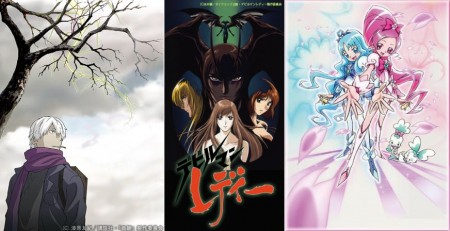Ask John: What are the Best Monster of the Week Shows?

Question:
What, in your opinion, are the best “monster of the week” anime series?
Answer:
Ironically the very concept of “monster of the week” is used to denote repetitive, redundant shows that lack inspiration, creativity, and, most importantly, narrative complexity. However, a blunt and complete dismissal of programs that introduce a predictable new but repetitive conflict to be faced and overcome in numerous subsequent weekly episodes is a hasty and unfair conclusion that overlooks the possibility inherent within the structure and overlooks some excellent series. The “monster of the week” categorization applies justifiably to numerous classic and beloved anime including Sailor Moon, Gegege no Kitaro, Jigoku Sensei Nube, Pocket Monster, and Hyakuju Ou Go Lion. Numerous other anime series including Evangelion, Bokurano, Betterman, and Madoka Magica utilize the repetitive structure of sequential monster antagonists but diversify or shift focus sufficiently to escape the label of “monster of the week” show. Within the dreaded label, however, are still a number of shows that use the formula to great advantage.
The “monster of the week” formula is typical for modern magical girl anime including Sailor Moon, Tokyo Mew Mew, Pretty Samy, Wedding Peach, and Kamikaze Kaitou Jeanne, but select shows have elevated themselves in spite of their repetitive structure. The first half of the 1998 Cardcaptor Sakura television series is redundant Clow Card antagonist of the week formula but unique approaches to secure each weekly antagonist and strong character development outside of the routine adventure sequences made the show interesting and unique. Similarly, strong narrative and occasional unexpected variances in the weekly monster appearance have helped the best entries of the Pretty Cure franchise – Futari wa Precure, Futari wa Precure Max Heart, Heartcatch Precure, and the current Doki Doki Precure – become fan favorites. The series’ having such compelling narrative and character development, especially in the first two seasons, that the monster battles seemed like obligatory distractions instead of the series’ raison d’être is evidence of the show surpassing its formula. Furthermore, occasional surprises including unexpectedly strong or unusually weak, or particularly impractical and ridiculous monster appearances have gone a long way toward making the predictable routine feel fresh and charming.
The 2002 RahXephon robot anime series tread in the structural footsteps of Evangelion yet felt like it stuck a little bit closer to the conventional “monster of the week” formula for a little bit longer than Evangelion did. However, like Evangelion, RahXephon surrounded its routine robot conflicts with sufficient intrigue, mystery, angst, philosophical conflict, and shadow politics to make the show compelling and fascinating. While Evangelion used its human character relationships to develop an oppressive, ominous tone, RahXephon used its repeated robot battles to achieve the same effect.
Similarly, the 1998 Devilman Lady television series effectively used its grim and grotesque monster of the week conflicts to pile up a sinking, defeating sense of morbid inevitable horror and tragedy. Even though the protagonist emerged victorious from her weekly battles, the sum total of her conflicts amounted to a bloody, emotionally frayed apocalyptic resolution.
Director Gisaburo Sugii’s 1969 TV series adaptation of Osamu Tezuka’s horror/samurai manga Dororo largely adheres to a routine monster antagonist of the week formula but varies the formula a bit in the regard that it’s series protagonist Hyakkimaru that seeks out the monsters to fight each week instead of him defending himself from their antagonism. Moreover, the variety in the demons that Hyakkimaru faces, the challenge he encounters in defeating each of them, and the consistently oppressive morose tone of the show elevate the series from redundancy into a realm of unique, interesting creativity and unpredictability.
The 2008 Natsume Yujin Cho series and the 2005 Mushishi television series both adhere to a formulaic supernatural antagonistic encounter of the week structure, yet both shows rank among the finest anime productions ever created. Natsume Yujin Cho used its repetitive formula to unfold a series of sequential touching and frequently heartbreaking emotional and nostalgic stories about the fleeting nature of transitory relationships. Mushishi used its supernatural affliction of the week formula to introduce and steadily cement a history and mythology that seems entirely breathtakingly real and believable.
Add a Comment
You must be logged in to post a comment.


The original Guyver OAV, not that lousy “CW-friendly” 2005 reboot. And the mid-2000s Demon Prince Enma OAV. Also, I’m not as fond of it as I’d like to be, but the Vampire Princess Miyu’s tv show has its moments.
Actually, while Dororo was the title character in “Dororo,” the protagonist who sought out and killed the monsters was Hyakkimaru. In the second half of the anime (eps 14-26), his prominence was reflected by the title changing to “Dororo and Hyakkimaru” (or “Dororo to Hyakkimaru,” if you want to be completely accurate).
Surprised that John mentioned Devil Man Lady, considering how uneven it can get, compared to its male counterpart. Plus, in terms of ’98 anime, it kind of slipped under the radar amongst American fandom. [Kite, Perfect Blue, and the latter half of Berserk got all the glory that year.] At least it’s not a Shutendoji-style mess, though.
Crap. Fixed that Dororo error. I knew that. I watched the whole show. Own it on retail R2.
I’ve got that box set as well, John!
(Also made a Dororo AMV, apropos of nothing…)